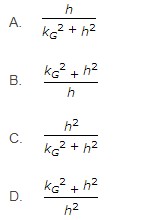31. The maximum frictional force, which comes into play, when a body just begins to slide over the surface of the other body is known as
A. static friction
B. dynamic friction
C. limiting friction
D. coefficient of friction
32. The center of gravity of an equilateral triangle with each side a is __________ from any of the three sides.

33. The distance, between the point of projection and the point where the projectile strikes the ground, is known as range.
A. Correct
B. Incorrect
34. The algebraic sum of the resolved parts of a number of forces in a given direction is equal to the resolved part of their resultant in the same direction. This is known as
A. principle of independence of forces
B. principle of resolution of forces
C. principle of transmissibility of forces
D. none of these
35. The triangle law of forces states that if two forces acting simultaneously on a particle, be represented in magnitude and direction by the two sides of a triangle taken in order, then their resultant may be represented in magnitude and direction by the third side of a triangle, taken in opposite order.
A. True
B. False
36. The angle between two forces when the resultant is maximum and minimum respectively are
A. 0° and 180°
B. 180° and 0°
C. 90° and 180°
D. 90° and 0°
37. The path of the projectile is a parabola.
A. True
B. False
38. The equivalent length of a simple pendulum which gives the same frequency as compound pendulum is

39. A redundant frame is also called __________ frame.
A. perfect
B. imperfect
C. deficient
40. Mass moment of inertia of a uniform thin rod of mass M and length (l) about its mid-point and perpendicular to its length is
